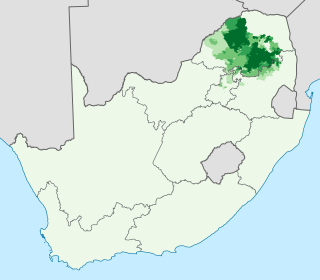
Back Noord-Sotho (taal) AF उत्तरी सोथो भाषा ANP لغة سوثو الشمالية Arabic Sesotho sa leboa AST Şimali Soto dili AZ قوزئی سوتو دیلی AZB Северен сото Bulgarian Sothoeg an norzh BR Pedi (llengua) Catalan Къилбаседа сото CE
| Northern Sotho | |
|---|---|
| Sesotho sa Leboa | |
| Native to | South Africa |
| Region | Gauteng, Limpopo, parts of Mpumalanga |
| Ethnicity | Pedi
Lobedu Pulana Tlôkwa |
Native speakers | 4.7 million (2011 census)[1] 9.1 million L2 speakers (2002)[2] |
Early forms | Tswaniac
|
Standard forms | Pedi |
| Latin (Northern Sotho alphabet) Sotho Braille Ditema tsa Dinoko | |
| Signed Northern Sotho | |
| Official status | |
Official language in | |
| Regulated by | Pan South African Language Board |
| Language codes | |
| ISO 639-2 | nso |
| ISO 639-3 | nso |
| Glottolog | pedi1238 Pedi |
S.32,301–304[3] | |
| Linguasphere | 99-AUT-ed |
 Geographical distribution of Northern Sotho in South Africa: proportion of the population that speaks a form of Northern Sotho at home.
0–20%
20–40%
40–60%
60–80%
80–100% | |
 Geographical distribution of Northern Sotho in South Africa: density of Northern Sotho home-language speakers.
<1 /km²
1–3 /km²
3–10 /km²
10–30 /km²
30–100 /km²
100–300 /km²
300–1000 /km²
1000–3000 /km²
>3000 /km² | |
| Pedi | |
|---|---|
| Person | Mopedi |
| People | Bapedi |
| Language | Sepedi |
Sesotho sa Leboa is a Sotho-Tswana language group spoken in the northeastern provinces of South Africa, most commonly in the Mpumalanga, Gauteng and Limpopo provinces and Botswana[4] It is also known by Pedi or Sepedi and holds the status of an official language in South Africa.[5][6]
An official language for the Lebowa homeland during apartheid, it is the first language of over 4.6 million (9.1%) people according to the South African National Census of 2011, making it the 5th most spoken language in South Africa.
- ^ Northern Sotho at Ethnologue (18th ed., 2015) (subscription required)
- ^ Webb, Vic. 2002. "Language in South Africa: the role of language in national transformation, reconstruction and development." Impact: Studies in language and society, 14:78
- ^ Jouni Filip Maho, 2009. New Updated Guthrie List Online
- ^ "NORTHERN SOTHO - South African Language Sepedi". www.sa-venues.com. Retrieved 8 June 2021.
- ^ "The SA Constitution". www.justice.gov.za. Retrieved 18 September 2023.
- ^ "free online course". www.unisa.ac.za. Retrieved 18 September 2023.